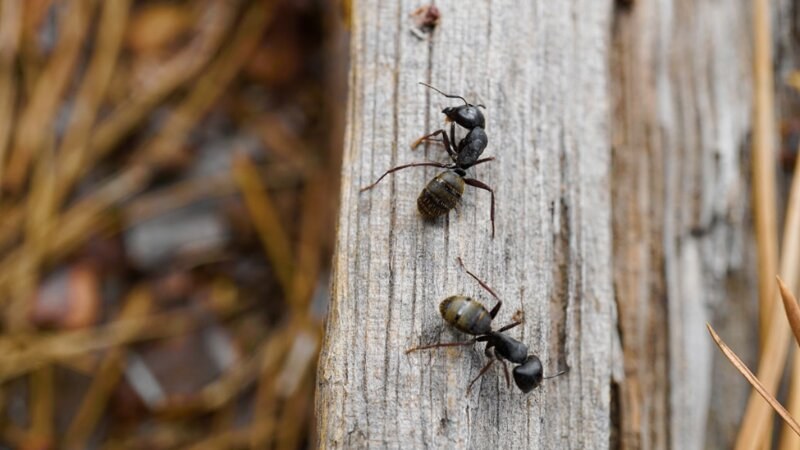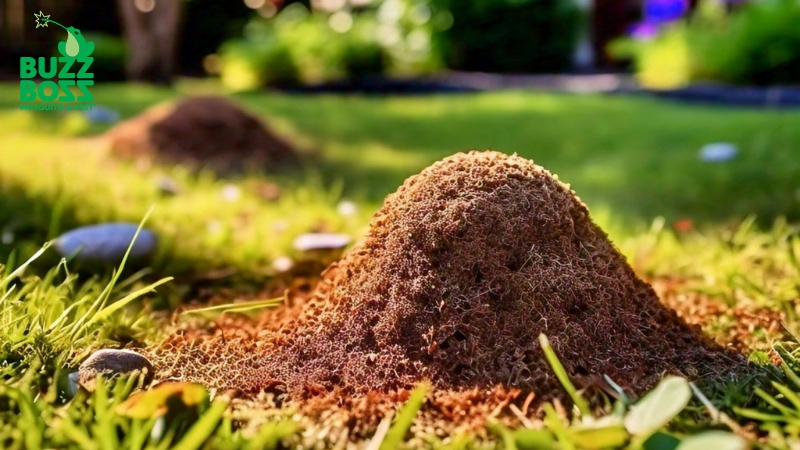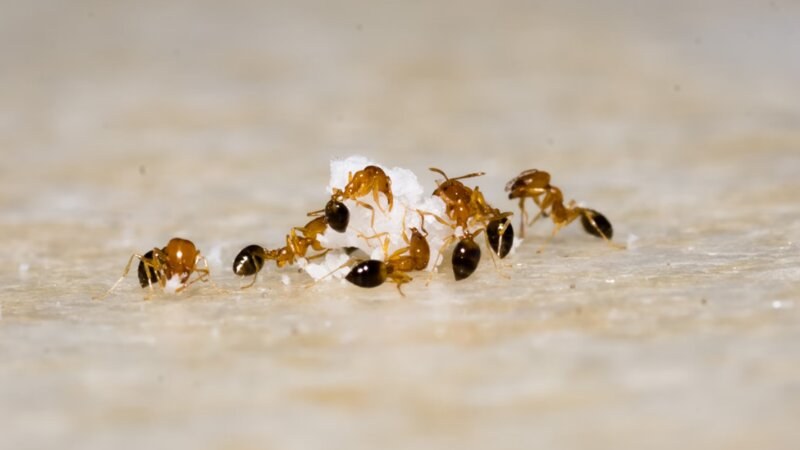Ant Behaviour Patterns in Red Deer: Understanding Trails, Nests, and Feeding Habits
Reading time: 8 minutesAre you facing increasing ant encounters in your Red Deer yard? That is not surprising, considering the city is home to over 100 documented ants. With such a diverse cast of tiny characters, you’re bound to cross paths every now and then.
While these tireless tiny troopers can be fascinating to watch, you definitely don’t want them to take residence in your space.
So, let’s dive into the world of ants inhabiting Red Deer and explore their trails, nests, and feeding habits!

Common Ant Species in Red Deer
Here are some of the most common ant species found in Red Deer:
1. Carpenter Ants
These large, black ants are known for creating nests by chewing through wood. They're attracted to moist wood and can damage your home's structure if left unchecked. Look for trails of large black ants and sawdust piles near entry points.
2. Pavement Ants
As the name suggests, these small, dark brown or black ants typically nest under sidewalks and driveways. Attracted to sugary spills and crumbs, they can become a nuisance. Look for small ant trails around your yard.
3. Pharoah Ants
Pharaoh ants are small, light yellow to reddish-brown ants, about 1.5 to 2 millimetres in length. They’re known for their exceptionally large colonies, which can contain hundreds of thousands of workers and numerous queens. Their colonies often consist of multiple interconnected nests, making them challenging to eradicate once they’ve made a home in your yard.
But that’s not all. Aside from being a nuisance, Pharaoh ants can also transmit pathogens, contaminating food and surfaces. So, if you’re having a party in your backyard, you don’t want these little guys crashing it.
4. Odorous House Ants
These tiny, reddish-brown ants emit a pungent odour when crushed, hence the name. They're attracted to sweets and grease and can be a persistent pest. Look for trails of small ants near trash bins.
5. Acrobat Ants
Typically small, ranging from 2.5 to 3 mm in length, Acrobat ants have a distinct heart-shaped abdomen and a dark brown or black colouration. They form colonies near moisture; this could be near wood, stumps, or woodpiles. These ants are also attracted to sweets and proteins, and food scraps, fallen fruit, and pet food are all great food sources for them.
Trailing the Ant Roadways
Have you ever seen a line of ants marching across your sidewalk in a perfect single file? That's their scout team leaving a trail of pheromones—a unique scent—to guide their fellow foragers to yummy food sources.
Think of it as an ant's version of Yelp, leading them to the next big brunch spot (in your case, maybe those stray crumbs!)
Here's a deeper dive into the science behind these trails:
- Pheromone Power. Upon finding a food source, Scout ants lay down a trail of pheromones with their feet as they travel back to the nest. These pheromones act as a chemical signal for other worker ants, attracting them to the food source.
- Trail Recruitment. As more ants follow the trail and reach the food source, they lay down pheromones, strengthening the signal and attracting even more ants. This creates a positive feedback loop, leading to a seemingly endless line of ants marching to and from the food.
- Trail Maintenance. Pheromones are constantly evaporating, so scout ants will periodically revisit the trail and reinforce it with fresh pheromones, ensuring a clear path for their forager kin.
Home Is Where the Nest Is: Finding the Source

Now, those marching ants have to come from somewhere, right? Unfortunately, ant nests can be tricky to find. Here are some common places where the nests may be:
- Underground Nests: Many ant species, such as fire ants and Argentine ants, build underground nests in soil. These nests can be found in open areas of the yard, along the edges of sidewalks or driveways, and under rocks or pavers.
- Underneath Structures: Ants may establish nests underneath structures such as decks, patios, or garden sheds. These areas provide shelter and protection from the elements.
- In Mulch Beds: Mulch beds are an attractive nesting site for ants because of their moisture-retaining properties. Ants may build nests within the mulch, especially if it’s thick and undisturbed.
- Around Trees and Shrubs: Ants may nest near the base of trees and shrubs, particularly if there are cracks or crevices in the soil or tree roots. They may also build nests in rotting wood or leaf litter around these plants.
- Near Food Sources: Ants are attracted to food sources. Check your outdoor dining areas, barbecue grills, and compost bins.
- In Potted Plants: They may build nests in potted plants, especially if the soil is moist and organic materials are present. They’re also attracted to the sweet nectar produced by certain plants.
- Along Fence Lines and Edges: With a serious infestation, you may see ant trails along fence lines, retaining walls, or other yard edges. These areas provide clear pathways for foraging ants to travel between their nest and food sources.
Tips For Finding the Ant Infestation Source
Here are some tips to help you locate the source of the infestation:
Follow the Trail
Sometimes, you can follow the trail of ants back to their nest. However, be aware that some ant species, like carpenter ants, forage long distances from their nest, making this method less reliable.
Look for Signs
Look for soil piles near your foundation, tiny holes leading under the house, or increased ant activity around specific areas. Carpenter ants, for example, might be making a home in your wooden deck, creating sawdust piles near the entry point.
Seek Professional Help - Ant Control in Red Deer
If you're struggling to locate the nest or the infestation seems out of control, don't hesitate to call Buzz Boss, your local ant control company. We have the expertise and tools to locate and eliminate the nest effectively.
Dinnertime Delights: What Are Ants Attracted To?

Let's face it: no one wants uninvited guests at dinner. So, what kind of food are ants most interested in? These little scavengers have a diverse palate, but here are some common foods they love:
- Sugary Treats. Sweets, crumbs, and sugary spills are a top attraction for many ant species.
- Grease and Oils. Don't underestimate the appeal of grease and oils for some ant species. Leaving food scraps in your yard or failing to clean greasy spills can attract these unwanted pests.
- Pet Food. Leaving pet food bowls out all day can be a constant delight for ants.
- Moisture. Many ant species are also attracted to moisture. Leaking pipes, overflowing drains, or even condensation build-up can create a damp environment that attracts these thirsty insects.
How to Keep the Ants Out
By understanding these attractants, you can take steps to make your yard less appealing to ants:
Cleanliness Is Key
Keep your yard clean and free of food debris. Regularly remove fallen fruit, crumbs, and pet food from outdoor areas. Clean up spills promptly.
Store Food Properly
Did you just have a BBQ party and want to leave the cleanup for tomorrow? That might be a problem. Don't leave food lying around uncovered. Store food in sealed containers, including pet food bowls, to eliminate the chances of an infestation and food contamination.
Take Out the Trash
Don't let the garbage pile up. Empty your trash cans regularly and make sure they have tight-fitting lids to prevent curious ants from exploring their contents.
Address Moisture Issues
Fix leaky pipes, repair overflowing drains, and address any areas with excessive condensation build-up.
Use Ant Baits
Place ant baits strategically around your yard to attract foraging ants. Follow the instructions carefully, as different baits work in different ways. Some baits are designed to be carried back to the nest, where they can eliminate the colony.
Create Physical Barriers
Use barriers like gravel or landscaping fabric to create a buffer zone between your yard and ant nesting sites, such as neighbouring wooded areas or overgrown vegetation.
Use Natural Repellents
Certain essential oils, like peppermint and citrus, have natural ant-repellent properties. While not a guaranteed solution, placing cotton balls soaked in these oils around your yard might deter them.
Proactive Ant Pest Control
Buzz Boss’s BuzzShield® Insect package is designed to protect your outdoor space from these tiny invaders. With this treatment, we create an invisible barrier around your yard to keep it bug—and pest-free.

When to Call Buzz Boss Ant Control in Red Deer
If you've tried all DIY ant control methods and the problem persists, or if you suspect an ant infestation, it's time to call in the professionals. Book your ant control service here.
We go beyond the ordinary of just fixing your problem. We believe in proactive pest control to eradicate the very likelihood of a pest infestation with our pest control packages:
- BuzzShield® Insect (Protection from all insects—mosquitoes, ticks, ants, and spiders)
- BuzzShield® Rodent (Effective on all rodents—mice, rats, and voles)
- BuzzShield® Complete (Protection from insects, rodents, and wasps)

